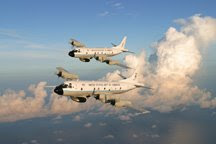It's been a busy couple of weeks around AOC and the tropics. When last I wrote we had experienced an engine problem on a flight into Tropical Storm Alex and had to suspend the remaining several planned flights into that system. Well, as expected there was a serious failure in the gearbox - that very complex part of the engine that connects the turbine or jet section of the engine to the propeller. Hence, we had to swap out the engine for a spare unit that we keep on hand. As it was, our crack maintenance team was able to accomplish the change and the test flight in a 12-hour shift. That was good because another Gulf disturbance, AL96, was close on its heels. But, I'll save that for later. Thought I'd use this opportunity to talk about the anatomy of a turboprop engine such as we have on our P-3s.
Simply put, a turboprop engine is a jet engine connected to a propeller by a very complex gearbox. Also attached to several of the engines are generators, which supply the necessary power for operating the aircraft and scientific equipment aboard, as well as engine driven compressors (EDC) which provide for the pressurization onboard as well as helping to cool the fuselage. Some of these are shown in the following pics.


The left shot shows the entire engine and prop assembly on the aircraft. The right photo shows some of the components in the engine after removal. The view is the reverse side of the engine.
Here are a couple of additional photos - the first showing a mechanic preparing the spline of the shaft that comes from the gearbox to the propellor; the second showing the after section or exhaust from the turbine; the third of the location where the engine will be inserted onto the wing mount; and finally the entire motor being lifted on the hoist in preparation for insertion into the mount.


And there you have the cliff notes on a turboprop engine like the ones we use on our P-3s. Simply put, air comes in the intake on top of the engine behind the spinning prop, enters the compressor to build the pressure as it enters the turbine. There fuel is injected and ignited driving the connection to the very complex gearbox which in turn spins the propellor. 90% of the thrust to drive the aircraft through the air comes from the props and only 10% from the jet exhaust. Unlike regular jet engines, these run at a constant speed, and thrust is obtained by changing the pitch of the prop, thereby grabbing more air and thrusting it under the wing giving you speed and lift. Elementary, I'd say.
Enough for this episode. I'll talk about AL96, which was last week, tomorrow.
Best to all.




No comments:
Post a Comment